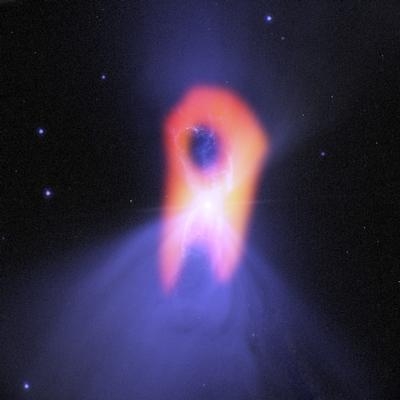Mon, Nov 04, 2013
Boomerang Nebula Structure 'Expanding Rapidly Into Space'
At a cosmologically crisp one degree Kelvin (minus 458 degrees Fahrenheit), the Boomerang nebula is the coldest known object in the universe -- colder, in fact, than the faint afterglow of the Big Bang, the explosive event that created the cosmos. Astronomers using the Atacama Large Millimeter/submillimeter Array (ALMA) telescope in Chile have taken a new look at this object to learn more about its frigid properties and to determine its true shape, which has an eerily ghost-like appearance.

"This ultra-cold object is extremely intriguing and we're learning much more about its true nature with ALMA," said Raghvendra Sahai, a researcher and principal scientist at NASA's Jet Propulsion Laboratory in Pasadena, CA, and lead author of a paper published in the Astrophysical Journal. “What seemed like a double lobe, or boomerang shape, from Earth-based optical telescopes, is actually a much broader structure that is expanding rapidly into space."
As originally observed with ground-based telescopes, this nebula appeared lopsided, which is how it got its name. Later observations with NASA's Hubble Space Telescope revealed a bow-tie-like structure. The new ALMA data, however, reveal that the Hubble image tells only part of the story, and the twin lobes seen in that image may actually be a trick of light as seen at visible wavelengths.
The researchers discovered a dense lane of millimeter-sized dust grains surrounding the star, which explains why its outer cloud has an hourglass shape in visible light. These minute dust grains have created a mask that shades a portion of the central star and allows its light to leak out only in narrow but opposite directions into the cloud, giving it an hourglass appearance. "This is important for the understanding of how stars die and become planetary nebulas,” said Sahai. “Using ALMA, we were quite literally, and figuratively, able to shed new light on the death throes of a sun-like star."
The Boomerang nebula, located about 5,000 light-years away in the constellation Centaurus, is a relatively young example of an object known as a planetary nebula. Planetary nebulas, contrary to their name, are actually the end-of-life phases of stars like our sun that have sloughed off their outer layers. What remains at their centers are white dwarf stars, which emit intense ultraviolet radiation that causes the gas in the nebulae to glow and emit light in brilliant colors.
(Image provided by NASA)
More News
The Airplane Made An Uncommanded Right Yaw And Roll, And He Was Unable To Maintain Control Of The Airplane On November 11, 2025, about 1750 central standard time, a Cirrus SR20, N8>[...]
Aero Linx: Florida Antique Biplane Association "Biplanes.....outrageous fun since 1903." That quote really defines what the Florida Antique Biplane Association (FABA) is all about.>[...]
Wind Shear Escape An unplanned abortive maneuver initiated by the pilot in command (PIC) as a result of onboard cockpit systems. Wind shear escapes are characterized by maximum thr>[...]
“Working closely with the Polish Armed Forces, we’re focused on disciplined execution to help enhance Poland’s defense capabilities and keep up with the strong de>[...]
Also: Bell 505 on SAF, NYPA Gets Flak For BizAv 'Abuse', FAA Venezuela Caution, Horizon Update Textron Aviation has confirmed it will be ending production of the Beechcraft Bonanza>[...]
 NTSB Prelim: Cirrus Design Corp SR20
NTSB Prelim: Cirrus Design Corp SR20 ANN's Daily Aero-Linx (11.30.25)
ANN's Daily Aero-Linx (11.30.25) ANN's Daily Aero-Term (11.30.25): Wind Shear Escape
ANN's Daily Aero-Term (11.30.25): Wind Shear Escape Aero-News: Quote of the Day (11.30.25)
Aero-News: Quote of the Day (11.30.25) Airborne 11.26.25: Bonanza-Baron Fini, Archer v LA NIMBYs, Gogo Loses$$$
Airborne 11.26.25: Bonanza-Baron Fini, Archer v LA NIMBYs, Gogo Loses$$$



